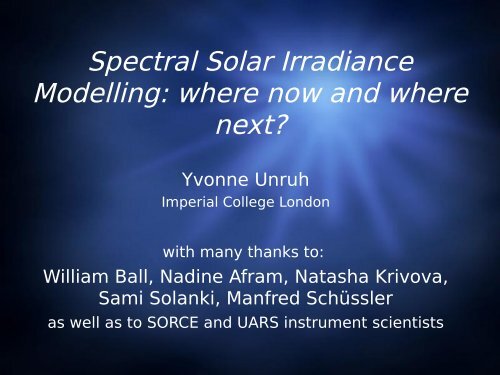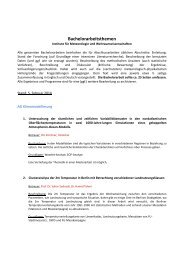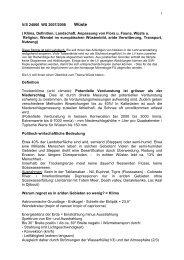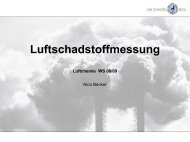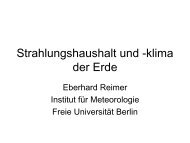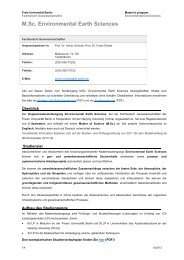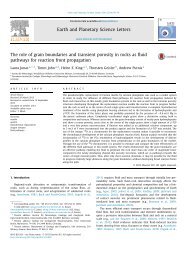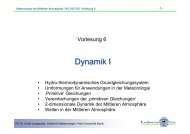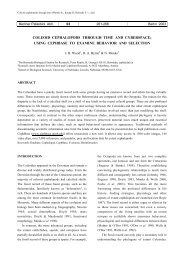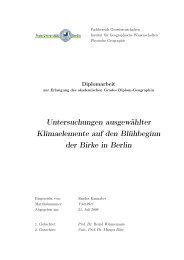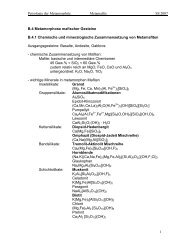Yvonne Unruh
Yvonne Unruh
Yvonne Unruh
You also want an ePaper? Increase the reach of your titles
YUMPU automatically turns print PDFs into web optimized ePapers that Google loves.
Spectral Solar Irradiance<br />
Modelling: where now and where<br />
next?<br />
<strong>Yvonne</strong> <strong>Unruh</strong><br />
Imperial College London<br />
with many thanks to:<br />
William Ball, Nadine Afram, Natasha Krivova,<br />
Sami Solanki, Manfred Schüssler<br />
as well as to SORCE and UARS instrument scientists
Overview<br />
• Spectral solar irradiance: what do we<br />
know?<br />
• Tests of SSI models<br />
– Long-term inconsistencies?<br />
– Short term uncertainties<br />
• SSI from magneto-convection<br />
simulations<br />
• Conclusions
State of Affairs?<br />
Measurements models<br />
TSI rotational �����������������������<br />
cycle �����������������������<br />
����������cycle minima ? (�)<br />
Maunder min �����������������������?<br />
SSI rotational ���������������������(for most λ)<br />
cycle �and������������������(for some λ?)<br />
(wavelength dependent)<br />
cycle minima �����������������������?<br />
Maunder minima �����������������������?
What are the problems?<br />
Measurements:<br />
- Lack of continuous measurements<br />
- Insufficient overlap between different instruments<br />
- Calibration once instruments are in space /<br />
degradation corrections<br />
Models:<br />
- What produces the irradiance variations? (Can we<br />
just extrapolate from rotational → cyclic → secular<br />
variability?)<br />
- What are best / sufficient tracers?<br />
- Uncertainties in contrasts:<br />
– spectral synthesis<br />
– model atmospheres
Tests of Contrast Calculations<br />
SATIRE:<br />
- continuum images → spot coverage<br />
- magnetograms → facular filling coverage<br />
Time<br />
dependent<br />
- emergent contrasts<br />
– Currently not feature dependent,<br />
though scaled according to magnetic<br />
field of features<br />
– (cf Shapiro et al; Fontenla et al;<br />
Ermolli et al for different<br />
approaches)
Tests of Contrast Calculations
Tests of Contrast Calculations
SATIRE – SIM: comparisons<br />
200 - 300 nm
SATIRE – SIM: comparisons<br />
200 - 300 nm<br />
facular brightening too large<br />
(mainly during active phases)
SATIRE – SIM: comparisons<br />
970 - 1600 nm
SATIRE – SIM: comparisons<br />
lack of filling-factor<br />
sensitivity?<br />
970 - 1600 nm
+ SATIRE<br />
� SORCE/SIM<br />
SATIRE – SIM: in detail<br />
During May 2004 –<br />
reasonably active time
+ SATIRE<br />
� SORCE/SIM<br />
SATIRE – SIM: in detail<br />
During May 2004 –<br />
reasonably active time
Early<br />
2008 –<br />
much<br />
more<br />
quiet<br />
time<br />
SATIRE – SIM: in detail<br />
SIM<br />
SATIRE
spots and faculae: cycle vars<br />
spots<br />
total<br />
faculae
spots and faculae: cycle vars<br />
total<br />
spots<br />
faculae
MURaM<br />
Magnetoconvection simulations:<br />
288 x 288 x 100 points<br />
corresponding to<br />
6 x 6 x 1.4 Mm<br />
mean vertical magnetic flux:<br />
0, 50, 200 & 400 G<br />
vertical velocity<br />
Temperature vertical mag flux<br />
see Vögler et al 2005, A&A 429,<br />
5000 K<br />
10000 K<br />
↓ 9<br />
km/s<br />
↑ 9<br />
km/s<br />
2 kG<br />
-1 kG
From MURaM to disk-centre intensities 1:<br />
T B<br />
Tot<br />
al<br />
Mg G<br />
band II<br />
UV<br />
(268nm)<br />
Missing:<br />
B for<br />
200G<br />
run<br />
5 μ
From MURaM to disk-<br />
centre intensities 2:<br />
G-band images for different<br />
mean mag fluxes<br />
50<br />
G<br />
200<br />
G<br />
0<br />
G<br />
400<br />
G
mag<br />
pore<br />
mag<br />
bright<br />
point<br />
Individual features<br />
lane<br />
granule
Individual features
50 G<br />
200 G<br />
400 G<br />
MURAM<br />
disk-centre<br />
contrasts:<br />
50 G<br />
200 G<br />
400 G
S<br />
A<br />
T<br />
I<br />
R<br />
E<br />
Average limb-behaviour
S<br />
A<br />
T<br />
I<br />
R<br />
E<br />
+<br />
M<br />
U<br />
R<br />
A<br />
M<br />
Average limb-behaviour
Conclusions<br />
• Excellent agreement between models and<br />
observations on rotational timescale<br />
- some (small) uncertainties in UV and NIR<br />
• Are starting to understand cycle variations; SIM<br />
long-term trends seem unlikely starting with<br />
magnetically induced changes<br />
• Magneto-convection simulations allow the<br />
calculation of ab-initio contrasts<br />
– dependence of spectral shape on magnetic flux<br />
– Initial results are encouraging, but also some<br />
surprises... not straightforward!
SATIRE background<br />
<strong>Unruh</strong> et al 1999, A&A 345, 635<br />
Fligge et al 2000, A&A 353, 380<br />
Reconstructions (cyclical and shorter<br />
timescales)<br />
Krivova et al 2003, A&A 399, L1<br />
Wenzler et al 2006, A&A 460, 583<br />
<strong>Unruh</strong> et al 2008, A&A 486, 311<br />
Long-term reconstructions<br />
Krivova et al 2007, A&A 467, 335 (and refs<br />
therein)<br />
MURaM background


